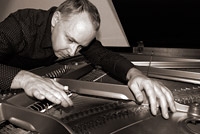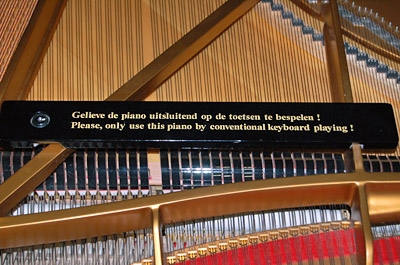Dissertation
Extended piano techniques : in theory, history and performance practice
Playing the piano with your forearm, plucking the strings, sawing through the piano: pianist Luk Vaes's doctoral dissertation covers all the techniques of play for which a piano is NOT designed. His defence ceremony will consist of three concerts and a public defence. 'Musicians were using the interior of their instruments 'as early as 1790.'
- Author
- Luk Vaes
- Date
- 22 December 2009
- Links
- Full text available in Leiden Repositiory
 So-called "extended techniques" have suffered a consistent lack of understanding from a theoretical, historical and practical point of view. Although most of them – e.g. playing directly on the strings, cluster- and glissando-techniques – exist in a substantial part of the repertoire for the piano and have done so for more than a couple of centuries now, the use of the techniques on stage still sparks off negative reactions by audiences, composers, performers and tuners as well as owners of pianos.
So-called "extended techniques" have suffered a consistent lack of understanding from a theoretical, historical and practical point of view. Although most of them – e.g. playing directly on the strings, cluster- and glissando-techniques – exist in a substantial part of the repertoire for the piano and have done so for more than a couple of centuries now, the use of the techniques on stage still sparks off negative reactions by audiences, composers, performers and tuners as well as owners of pianos.
Any one-sided approach towards appreciation has proven to be inadequate: academic analyses do not succeed in handling the matter satisfactorily, endeavors by musicians to teach and advise on the "proper" use of the techniques have come short of applying an in-depth and a historically informed perspective. A comprehensive and exhaustive survey of the extended techniques as a whole can serve to alleviate the risk that the relevant repertoire sinks into oblivion, contributing to a reassessment of the subject, in turn benefitting contemporary professional performance practice, concert programming, composers’ interest and musical as well as music-historical education.
 The subject and its related terminology are scrutinized and (re)defined where necessary. The acoustical properties of the techniques are explained from the perspective of the performer to ensure proper insight in the way they produce sound. Over 16.000 compositions have been considered to write the history of improper piano playing, comparing manuscripts with first and subsequent editions of solo as well as chamber and concerto music, original compositions as well as transcriptions, from the "classical" as well as the "entertainment" sector.
The subject and its related terminology are scrutinized and (re)defined where necessary. The acoustical properties of the techniques are explained from the perspective of the performer to ensure proper insight in the way they produce sound. Over 16.000 compositions have been considered to write the history of improper piano playing, comparing manuscripts with first and subsequent editions of solo as well as chamber and concerto music, original compositions as well as transcriptions, from the "classical" as well as the "entertainment" sector.
Original preparations collected by John Cage were tracked down and described in minute detail so that alternatives can be considered on the basis of professional information. Historical recordings as well as personal experiences and interviews with composers are used to pinpoint historical performance practices. To help the pianist prepare for concerts with the relevant repertoire, measurements of the internal layout of the most common grand pianos are listed in order to anticipate possible problems in advance.
